Max brought 4 of his siblings to the USA around the turn of the century, but was he able to get the rest of his family out of Latvia, or did they perish in the Holocaust?
As far as we know, Max, was the oldest child of Etel Smarkovitch and Hirsch Leib HaLevy. According to family stories, he left Latvia rather than be conscripted in the Tzar’s army.
We believe that Max arrived in the United States around 1891. At that time, to get out of Latvia you needed exit passports. Because he was still of age to be conscripted, he probably had to bribe his way across the border. They probably would not have issued him the passports. Depending upon the port he sailed from, he probably took a long train ride across Germany or Poland to get to a port. No matter what steamship he sailed on, he would have been in the steerage class. He would be allowed to board the steamship only after passing a medical inspection. Here is a brief description of the sleeping quarters for single men in steerage in 1890:
In some cases they slept six in a large bunk, with bunks to the right of them, bunks to the left of them, bunks below them, and bunks above them.
Immigrant Journey in the Steerage – 1890
Once in the United States, he took a job peddling ice and coal door to door, carrying the ice on his back. Because Max Abramowitz is a common name, and because he travelled and lived alone, it is hard to find records for him. It appears he first lived on the Lower East Side in a tenement on Chrystie Street. We found a city directory listing for him in 1896. (1)
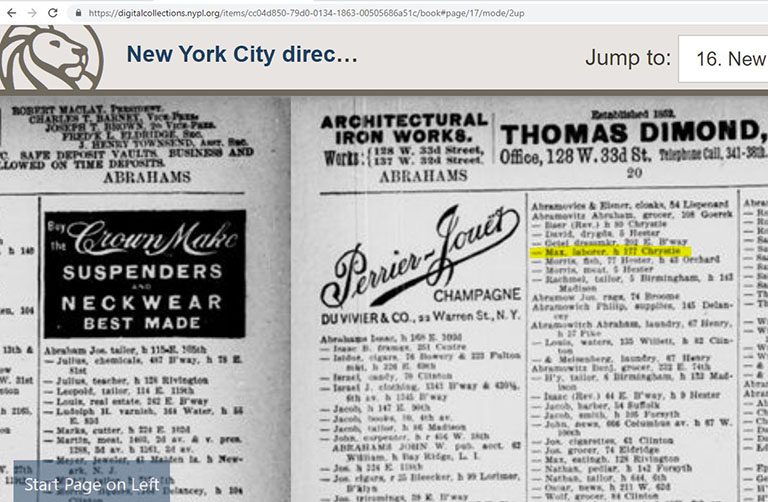
The image to the right could be one of his Naturalization documents. People did move around a lot so in 1899 he could have been living at 194 Madison Ave. That was still considered the Lower East Side.
Also, in the 1905 New York State Census, he is listed as a citizen, which meant he got his Naturalization before 1905.
.
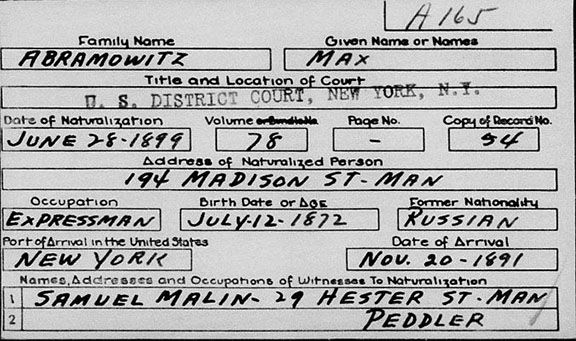
Max probably worshiped at Chevrah Agudath Achim Anshei Kurland V’Lida Orthodox Synagogue. As you will see later, he was on the the cemetery committee with his friend Jacob Bersohn.
Eldridge Street was also in the Lower East Side and therefore within close walking distance to where he was living. Also, this congregation consisted of people from where he emigrated from.
The Rabbis at the time were M. RIflein and M. Bluestone. (2)

Over the years, he saved enough money to send for four of his brothers and sisters to join him: Sarah, Gussie, Samuel, and Abe.
His brother, Sam, came first. He arrived on March 15, 1904. Next came his sisters, Gussie and Sarah. They arrived in late September of 1904. Abe would not come until the following year.
In the 1905 New York Census, Max, Sam, Gussie and Sarah are living in Max’s tenement apartment at 34 Chrystie Street on the Lower East Side. They were all working and I assume helping with the expenses. (3)
(Chrystie Street in the early 1900s –>) (4)
What is interesting is the Bersohns appear to be neighbors. Were they life-long friends or relatives? Did Max meet them on the ship, in New York, or back in the old country? The Bersohns were known to the entire family and Abe Bersohn and his sister, Celia, were even invited to my wedding.
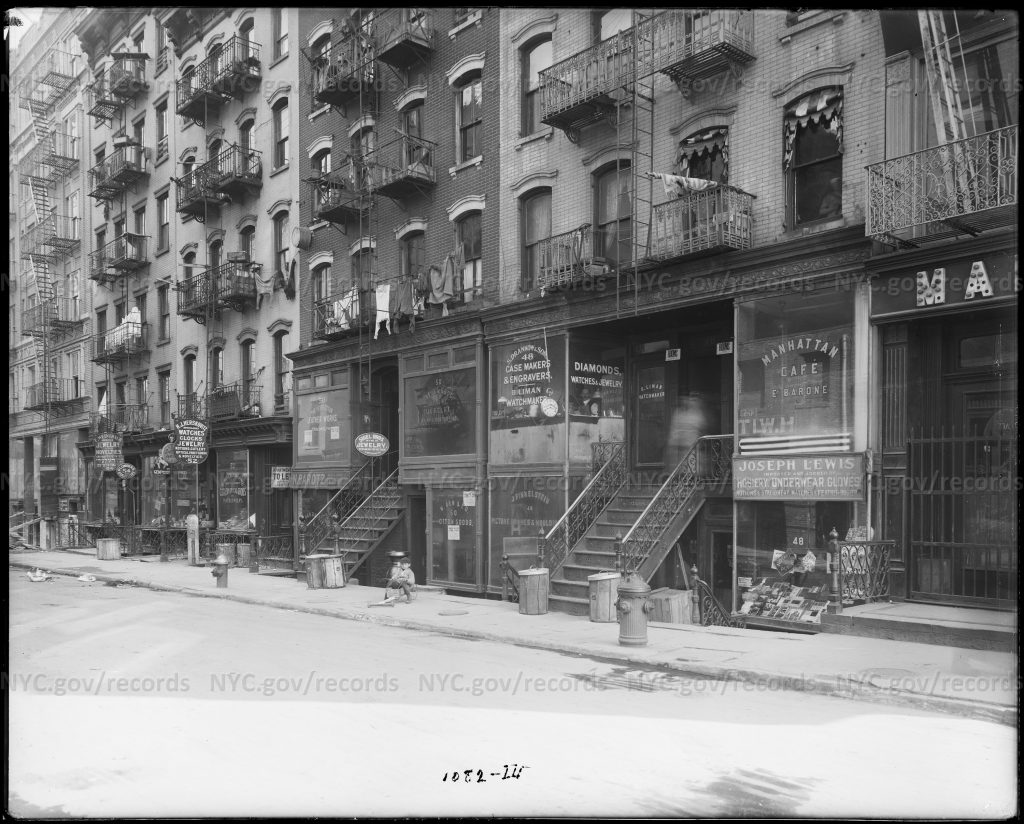
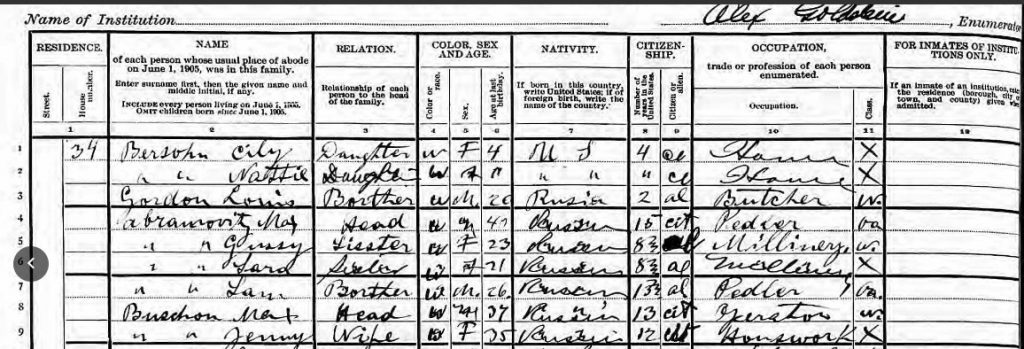
By 1908, Max moved the family uptown to 48 E. 107th. This listing appears in Trow’s General Directory for the boroughs of Manhattan and Bronx. (5)
On Gussie’s 1909 Marriage License, this was the address she used as her current residence. That is how we know this is the correct Max. What we don’t know, is were Sam, Sarah, and Abe all living there, too. Based on the 1910 Census (6) we can assume that at least Sarah and Sam were still living with him.


It appears his brother, Abe, was living on his own by the 1910 Census. Samuel got married in March of 2016, and Sarah got married in April of 1916. After having a house full of family, Max was now on his own. However, by 1920, he was living with Sarah and her family. (Note how his name is misspelled). (7)

I wonder how long he lived with Sarah and her family? I say that because my Aunt Mildred told me she was sent to clean her Uncle Max’s apartment after school. That was probably in the 1920’s as she graduated high school in 1931. I cannot find the 1930 Census for Max, but I know he was not living with Sarah’s family at that time according to the 1930 Census record for her family.
Max’s brother, Sam, died from a heart attack on January 22, 1933. His brother, Abe, died on May 5, 1934. Max became a surrogate father to Sam’s daughter and to Abe’s 6 children. He moved in with Sam’s widow and daughter according to the 1940 United States Census. There were living at 618 W. 177th Street in Manhattan. (8)

During WWII, he tried to get his 2 remaining brothers and their families out of Latvia, but to no avail. I can still remember the crying and screaming that occurred when we all found out they had perished.
When he was in his 50’s, he developed a heart condition and the doctors told him he had to stop working. For exercise, he would walk to the stock market where he started to invest. He was thus able to live comfortably on his investments.
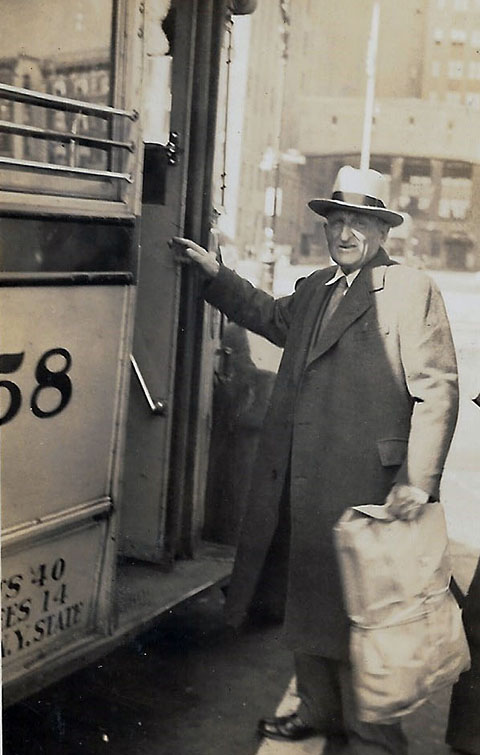
Below is a picture taken circa 1930. Comparing the handwriting on the back of the picture to other handwriting samples we have, I believe this is Uncle Max’s handwriting and that Isaac is a cousin from his mother’s Smarkovitch family What warmed my heart seeing this, is how Uncle Max referred to his mother as “mama”. That tells us how he still cared for his family in the Old Country even though he was separated from them.
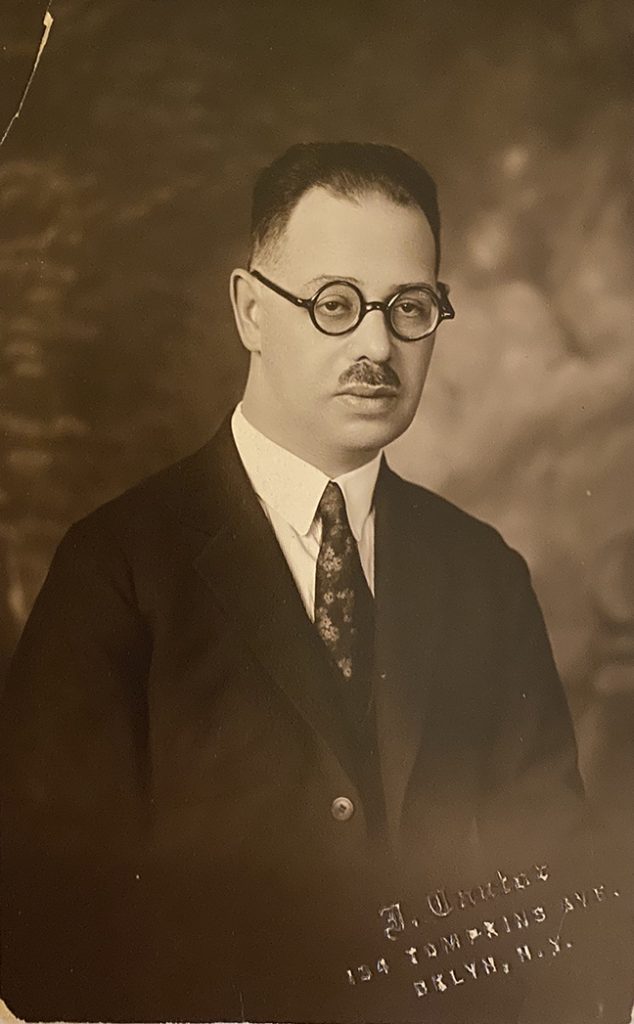
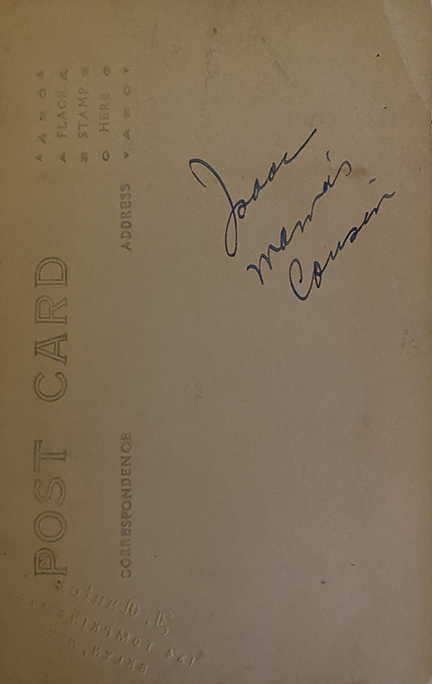
He often spent time with his neices and nephews. At right and below, he is posing with May, his nephew Bernie’s wife.
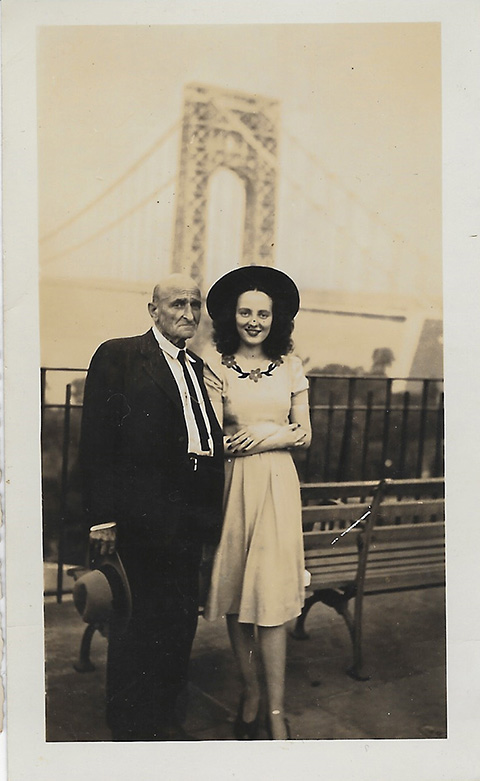
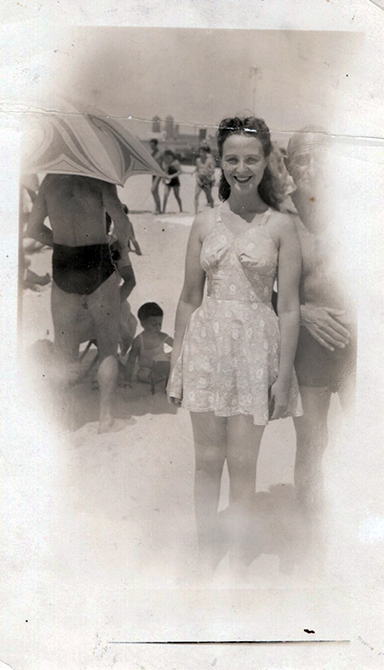
Here is Max at the wedding of his nephew, Bernie Blieden, September 18, 1945. Bernie is his nephew and the son of Max’s sister, Gussie. Max is standing next to Gussie.
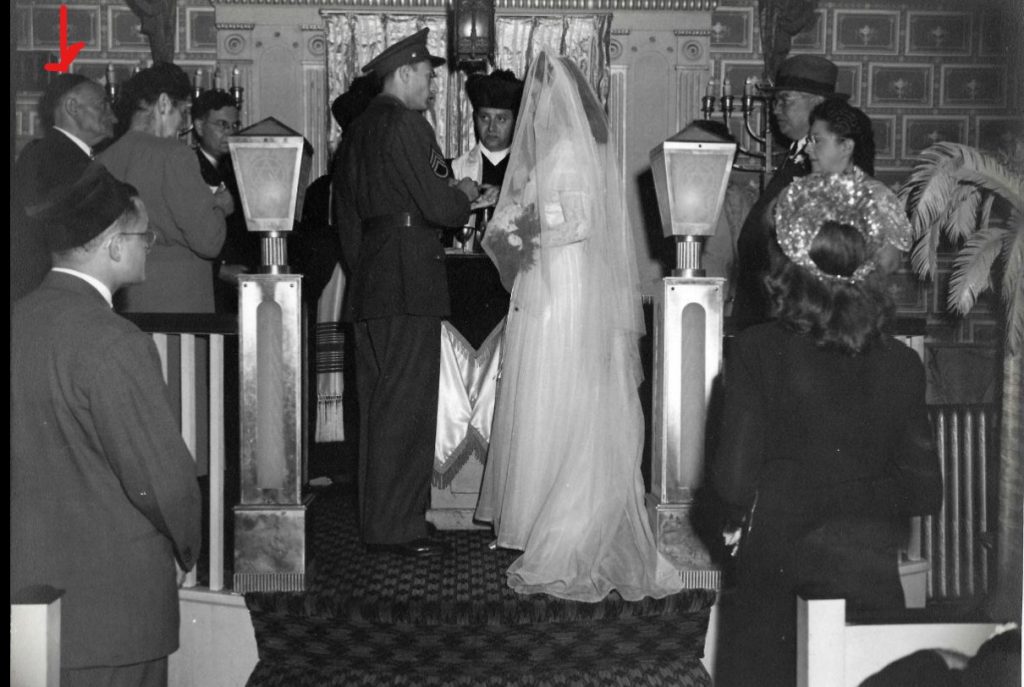
In 1947, while he was vacationing in Florida, he received news that May and Bernie had their first child. Below is the postcard he sent to congratulate them. He was staying at the Sea Breeze Hotel at 205 Collins Avenue, in Miami Beach. I wonder if he always stayed at the same hotel?
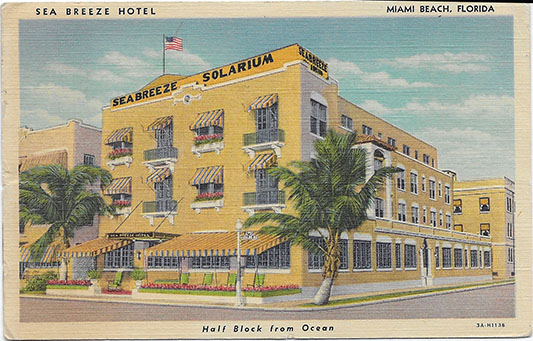
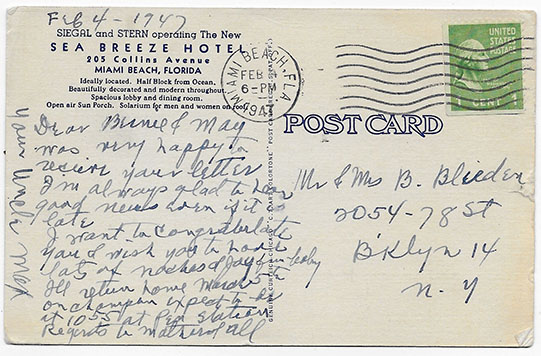
To get back and forth from New York City to Miami, Max probably travelled on the train, “Champion” part of the Atlantic Coast Railroad Line. The Champion was in daily service from December 1, 1939, until October 1, 1979. This train had very high standards and the company prided themselves on customer service. There were roomettes and double bedrooms, dining cars, and a tavern-lounge car. Unfortunately, the dinng cars were segregated until President Harry Truman passed a mandate ordering interstate carriers to desegregate in 1948. (9)
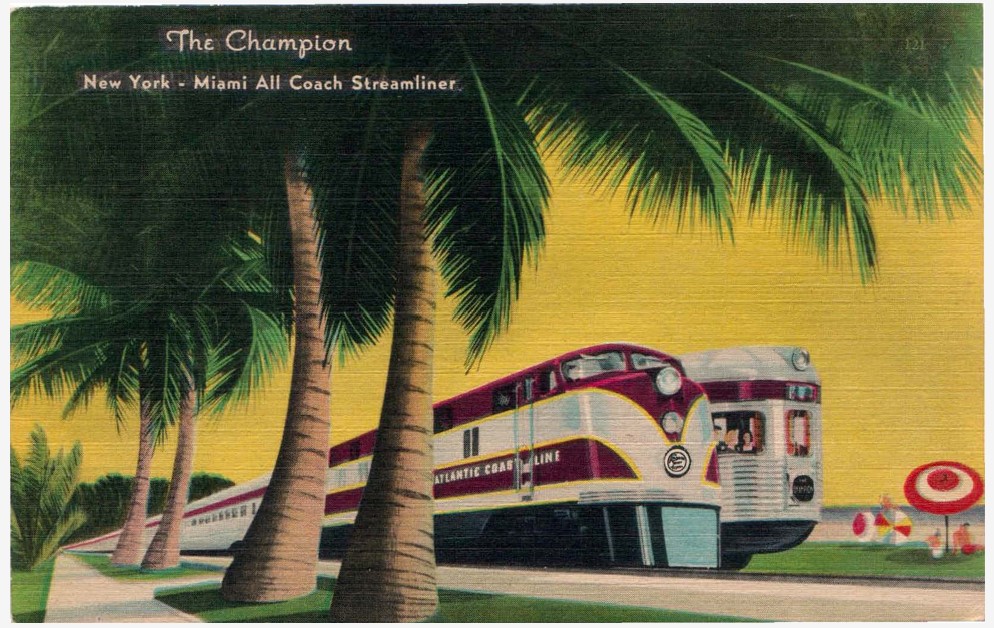
Leaving from Penn Station in New York City, the trip to Miami took about 24 1/2 hours. The average speed was about 60 miles per hour. (10 )
Towards the end of his life, Max needed someone to take care of him, so he bought his nephew, Bernie, a house knowing he would live with Bernie and his family. The house was in Teaneck, NJ.
We moved to the Teaneck house in the summer of 1957 and Uncle Max moved in with us. I went with my father to pick him up from the Bronx to bring him to his new home in, NJ. I can still remember that day. Max was living in a building and we took an elevator up to his floor. The hallway was long and dark. When we knocked on his door, he answered it with his hat and coat on and a small suitcase by his side. What I also remember and thought was strange, was an old man sitting on the right side of the room. They did not say one word to each other and Max just walked out with us.
When I think of my Great-Uncle Max, I remember how slowly he walked and how stooped over he was. On Shabbat he walked several blocks to attend synagogue at the Teaneck Jewish Community Center. I always worried about him crossing the busy Queen Anne Road since he walked so slowly. When he was at home, he mainly stayed in his room and prayed. My mother would make boiled potatoes and herring for him for Sunday dinner as that is what he enjoyed.
Cousin Maggie Farkas remembers that Uncle Max Uncle Max would pinch her cheeks and was always wearing a hat.
When winter arrived, Max went to FLorida as was his usual custom. My siblings and I along with my mother wrote to him while he was there.
Note that he stayed at the same hotel he stayed in in 1947.
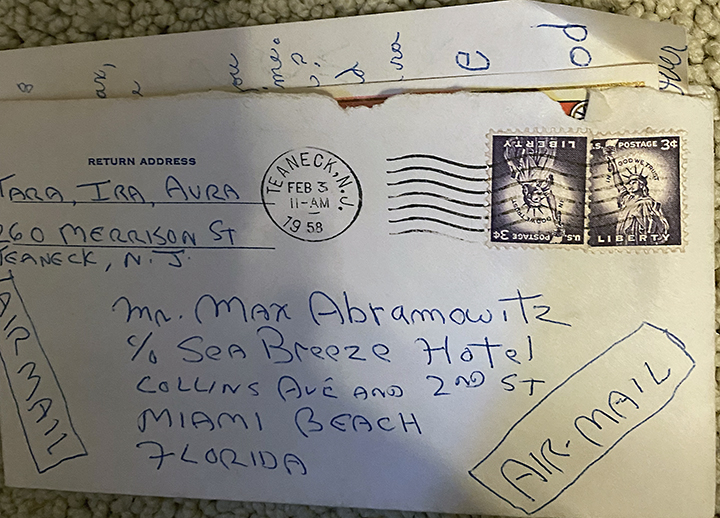
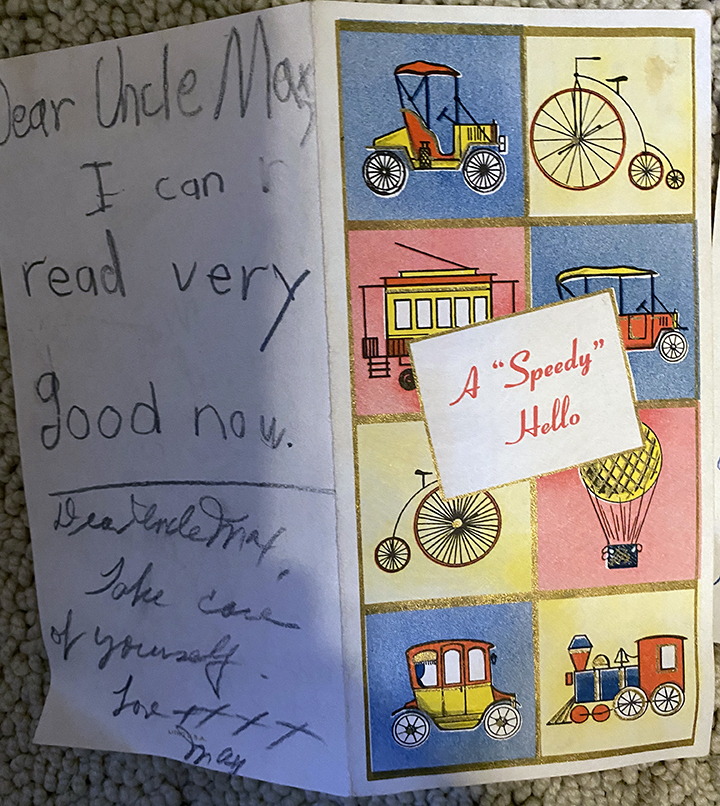
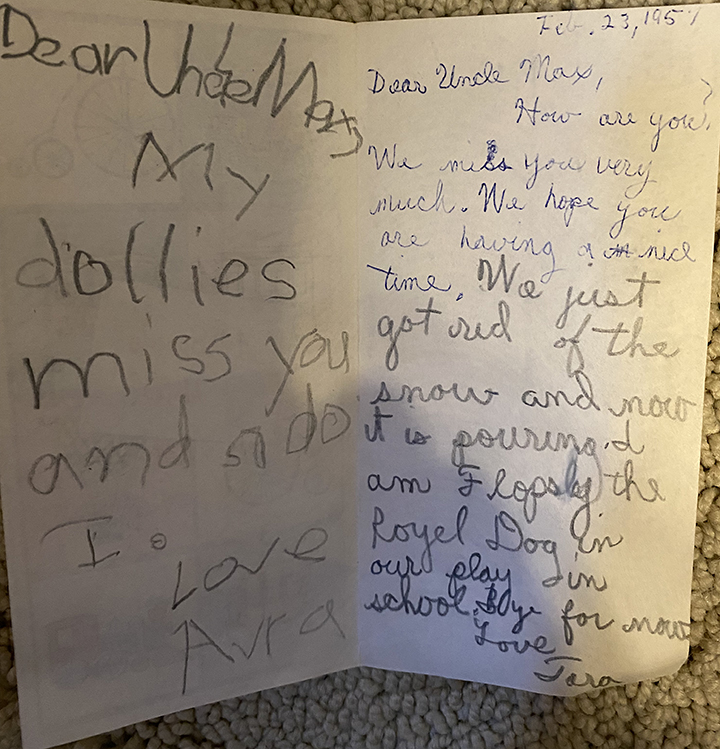
While in Florida, Uncle Max had a heart attack and died. He was 92. He is buried in Mt. Lebanon Cemetery in Glendale, Queens, NY. According to the cemetery, Uncle Max died on April 3rd in Miami, and was buried on April 4th in Queens, NY. To get the body there that quickly, it must have been sent via plane. On the cemetery records, his sister, Gussie, was listed as his relative.
He is buried in location K-22-2-6 in the Kurland & Lida Society section. His long-time friends (or were they relatives), Fanny and Jacob Bersohn, are buried in the same section. The Kurland & Lida Society at Mt. Lebanon Cemetery was organized in 1888. Both Jacob and Max (Mordechai) were committee members. The Society took its name from Kurland in Latvia, and Lida, in Belarus. (11 )
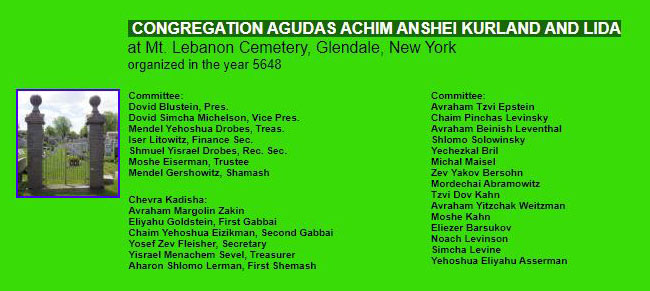
Below are family pictures taken at his unveiling.
The translation of his tombstone is “A pure and honest man, Our teacher Mordechai, son of Mr. Tzvi Hersh the Levi, Died 13 Nissan 5718”. He died the day before Passover in Florida which meant arranging for the funeral and burial in New York must have been extra-stressful while trying to get ready for Passover at the same time. (12)
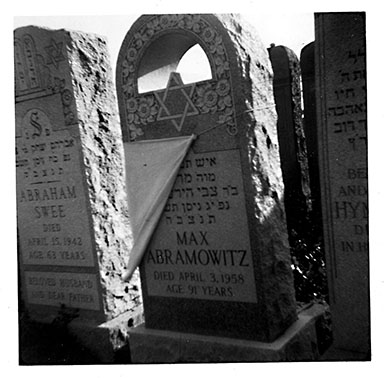
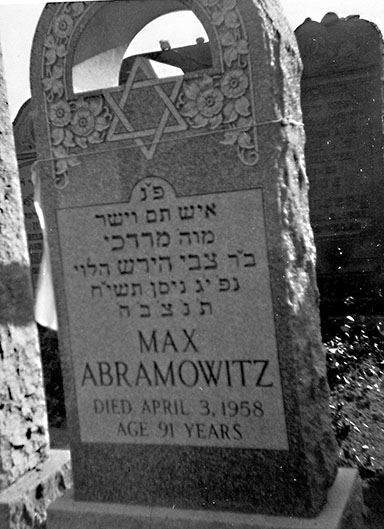

His Yiskor Plaque was installed in the Teaneck Jewish Community Center. Translated it says: “Mottel son of Hirsch Leib, the Levite”. According to the translators on the Facebook group Tracing the Tribe, “Mottel can be a given name in its own rights, but it is typically a nickname for the Hebrew name Mordechai.” (13)
Max dedicated his life to helping his family. When he died, everyone wondered who he left his money to. Aunt Mildred was disappointed when she was not named in the will and felt that was because she was a woman.
According to the Estate Settlement from Attorney Abe Bersohn, it looks as thought everything was left to Gussie’s sons, Arthur and Bernie.
Note that the attorney is a descendant of Max’s good friend (or could it be a relative?), Jacob Bersohn.
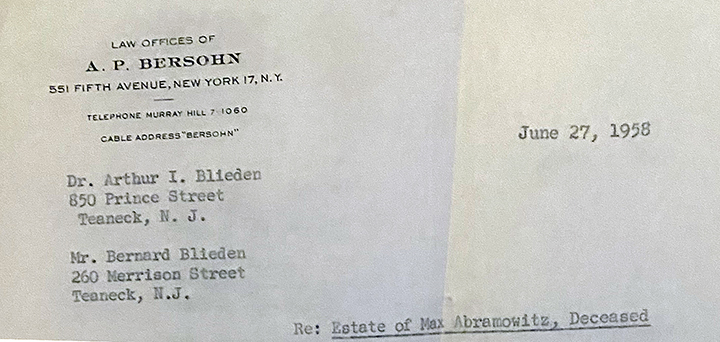
The year after Max died, my Uncle Arthur Blieden, and my father, Bernard Blieden, donated a Sefer Torah and accompanying silver plate to the Teaneck Jewish Community Center in their Uncle’s memory.
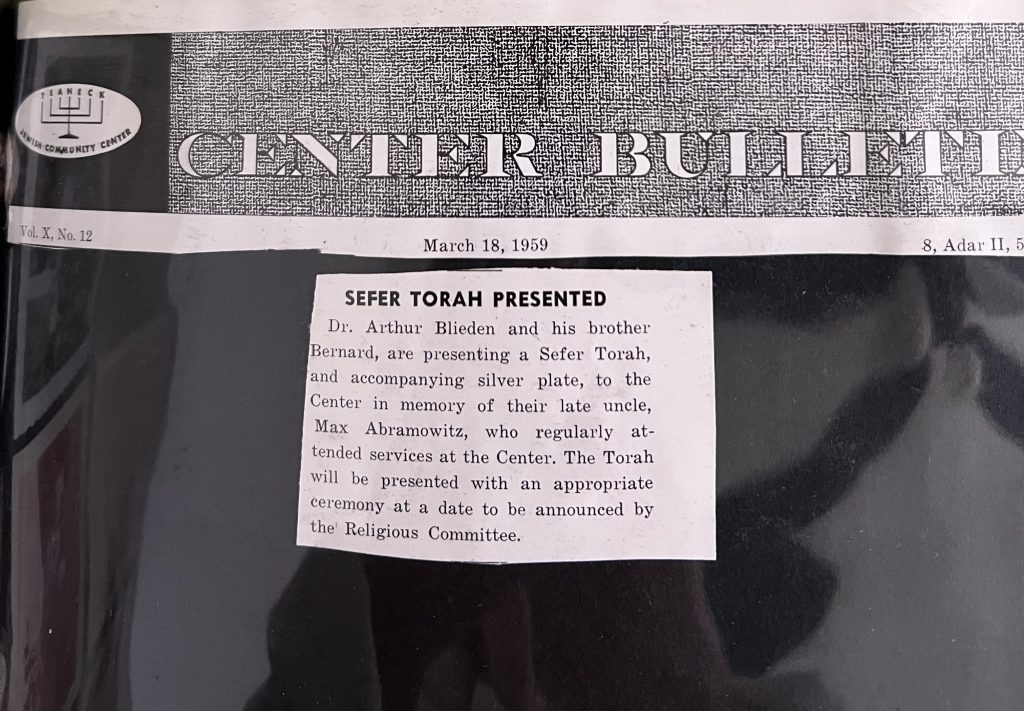
Sources
- Trow’s New York City Directory 1896-97
- Synagogue Listings for New York City and Long Island 1910-1915 courtesy of the Brooklyn Daily Almanac
- 1905 NY Census on Ancestry.com
- Chrystie Street
- 1908 Address Listing in Trow’s General Directory of the Boroughs of Manhattan and Bronx, August 1, 1909
- 1910 Census on Ancestry.com
- 1920 Census on Ancestry.com
- 1940 Census on Ancestry.com
- About the Champion (train)
- Streamliner Memories, Memorabilia From the Silver Age of Passenger trains: The Champion
- Kurland & Lida Cemetery Gates andFounding Committees
- The Facebook group “Tracing the Tribe” for translation of Max Abramowitz gravestone
- The Facebook Group :Tracing the Tribe” for translation of Max’s Yiskor plaque
Still Unknown
- What was Max’s early life like
- Exactly when did Max arrive in the US and on what steamship did he sail
- Where was he living in 1900
- Where was he living in 1930
- Where was he living in 1950
- Where the Bersohns friends or relatives
